#Armenian Apostolic Church
Text

was looking through some older photos and found this one of myself in Vank Cathedral, an Armenian Apostolic Church, located in Esfahan, Iran. Dated April 20, 2018
#it’s so beautiful i wanted to share it :)#also lol at 4/20#the history is rather sad tho. built in 1606 by Armenians forcibly resettled there by the shah of iran at that time#from their homeland. although they were free people there. but still#it’s located next to the Armenian ethnographic museum of new julfa#which is where I dropped my phone down a toilet lol#isfahan#esfahan#iran#Vank cathedral#Armenian apostolic church#Armenian#religious#church#new julfa#vank#cathedral#monastery#convent#apostolic#my pic#من
19 notes
·
View notes
Text



Armenian nuns of Gayane Monastery, 1910s, Tiflis, by D. Yermakov.
32 notes
·
View notes
Text
Today is Christmas in Armenia.
At least for the Armenian Apostolic Church.
Hence why I’m leaving this here.
I’ve always wondered why they celebrate it in January.
Still.
#dougie rambles#personal stuff#christmas#xmas#armenia#Armenian apostolic church#oriental orthodoxy#christianity#religion
2 notes
·
View notes
Text
Discover Armenia: A Travel Guide to the Land of History and Hospitality
Armenia, nestled in the South Caucasus region, is a country of ancient history, stunning landscapes, and rich cultural heritage. With its friendly locals and a blend of traditional and modern experiences, Armenia offers an unforgettable travel adventure. This guide will walk you through everything you need to know for a perfect trip to this enchanting land.
Brief History of Armenia
Armenia…

View On WordPress
#Activities for Tourists in Armenia#africa#Are there any health precautions I should take before traveling to Armenia?#armenia#Armenian Apostolic Church#Brief History of Armenia#Can I use my credit card everywhere in Armenia?#Cost of Living in Armenia#Cultural Tours#destinations#Discover Armenia: A Travel Guide to the Land of History and Hospitality#Do I need to speak Armenian to travel around the country?#europe#Festivals#Garni Temple#gata#Geghard Monastery#Hiking and Trekking#Is it easy to get around Armenia?#kenya#Lake Sevan#marshrutkas#norway#safari#Tatev Monastery#technology#travel#vacation#What is the best time to visit Armenia?#What traditional Armenian dishes should I try?
1 note
·
View note
Text
Remembering St. Jude Thaddaeus, the Apostle (19th August)
St. Jude, also known as Thaddeus, was a dedicated apostle of Jesus Christ, spreading His teachings across distant lands. Learn about his life, contributions, and enduring legacy in this comprehensive blog.
In the name of God the Father, Christ Jesus His Son and the Holy Spirit, One True God. Amen.
IntroductionIdentityNew TestamentJude – Brother of Jesus?Tradition & LegendLetter of St. JudeMartyrdom & RemainsIconographic RepresentationPatronage & Pilgrimage CentresConclusion
Introduction
On August 19th, we remember one of the 12 Apostles of Jesus and considered as the founding father and first…
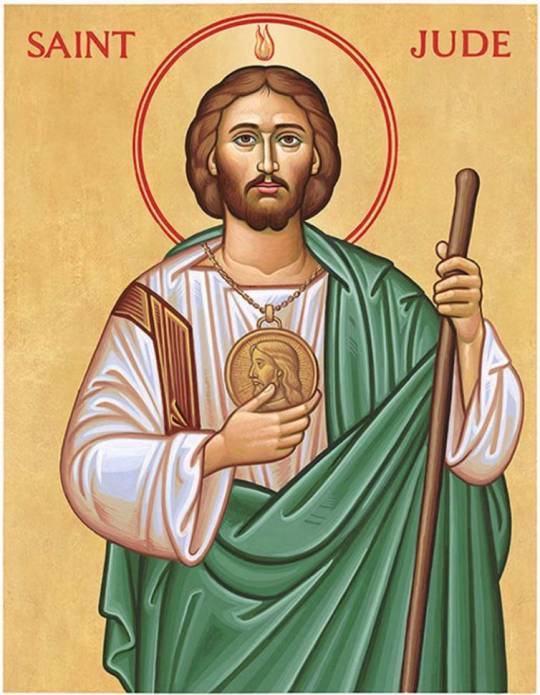
View On WordPress
#Apostle of Jesus#Apostle Thaddeus#Armenian Apostolic Church#Christian Martyr#Christian Tradition#Early Christian Movement#Epistle of Jude#featured#Gospel of Jude#image of Edessa#Jude&039;s Patronage#Legends of St. Jude#Martyrdom#Orthodox faith#Patron of Impossible Causes#Patron Saint#Pentecost#Saint Bartholomew#St. Jude#St. Jude&039;s relics
1 note
·
View note
Text
NATIONAL-RELIGIOUS EXTREMISM AND POLITICAL TERRORISM OF THE NATIONALISTS AS A DRIVING FORCE OF THE ETHNOGENESIS OF THE ARMENIAN ETHNOUS
(OUTLINE OF SOCIO-POLITICAL HISTORY)
Олег КУЗНЕЦОВ Oleg KUZNETSOV КАВКАЗ & ГЛОБАЛИЗАЦИЯ 176 Том 8 Выпуск 3—4 2014
Translated by Saadat Karimi
Summary
Through the prism of the content of the process ethnogenesis of the Armenian people the issues of the influence of organized national-religious extremism, political terror and terrorism on the vector and intensity of modernization…
View On WordPress
#Armenian Apostolic Church#Armenian-Gregorian clergy#ASALA#Dashnaktsutyun#ethnogenesis#Hunchak#JCAG#national-religious extremism#political terrorism#Republic Armenia#secularization#social modernization
0 notes
Text
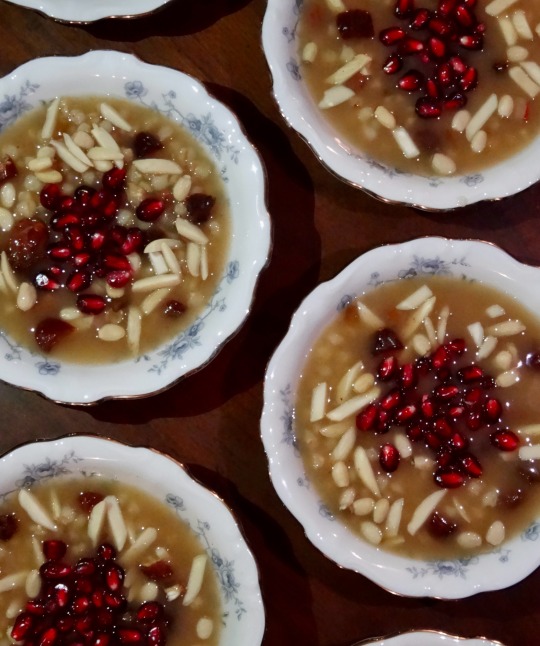
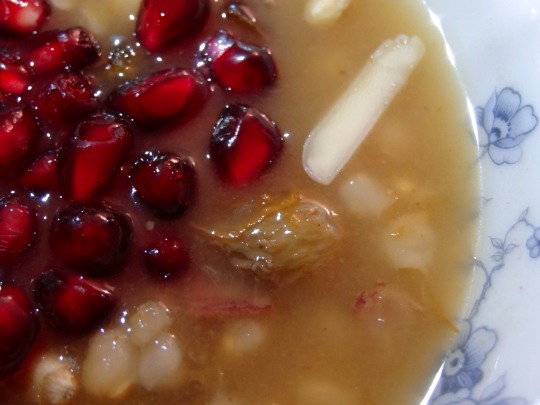
[ID: First image shows four small porcelain bowls of a pudding topped with slivered almonds and pomegranates seeds, seen from above. Second image is an extreme close-up showing the blue floral pattern on the china, slivered almonds, golden raisins, and pomegranate seeds on top of part of the pudding. End ID]
անուշապուր / Anush apur (Armenian wheat dessert)
Anush apur is a sweet boiled wheat pudding, enriched with nuts and dried fruits, that is eaten by Armenians to celebrate special occasions. One legend associates the dish with Noah's Ark: standing on Mt. Ararat (Արարատ լեռը) and seeing the rainbow of God's covenant with humanity, Noah wished to celebrate, and called for a stew to be prepared; because the Ark's stores were diminishing, the stew had to be made with small amounts of many different ingredients.
The consumption of boiled grains is of ancient origin throughout the Levant and elsewhere in West Asia, and so variations of this dish are widespread. The Armenian term is from "անուշ" ("anush") "sweet" + "ապուր" ("apur") "soup," but closely related dishes (or, arguably, versions of the same dish) have many different, overlapping names.
In Arabic, an enriched wheat pudding may be known as "سْنَينِيّة" ("snaynīyya"), presumably from "سِنّ" "sinn" "tooth" and related to the tradition of serving it on the occasion of an infant's teething; "قَمْح مَسْلُوق" ("qamḥ masluq"), "boiled wheat"; or "سَلِيقَة" ("salīqa") or "سَلِيقَة القَمْح" ("salīqa al-qamḥ"), "stew" or "wheat stew," from "سَلَقَ" "salaqa" "to boil." Though these dishes are often related to celebrations and happy occasions, in some places they retain an ancient association with death and funerary rites: qamh masluq is often served at funerals in the Christian town of بَيْت جَالَا ("bayt jālā," Beit Jala, near Bethlehem).
A Lebanese iteration, often made with milk rather than water, is known as "قَمْحِيَّة" ("qamḥīyya," from "qamḥ" "wheat" + "ـِيَّة" "iyya," noun suffix).
A similar dish is known as "بُرْبَارَة" ("burbāra") by Palestinian and Jordanian Christians when eaten to celebrate the feast of Saint Barbara, which falls on the 4th of December (compare Greek "βαρβάρα" "varvára"). It may be garnished with sugar-coated chickpeas and small, brightly colored fennel candies in addition to the expected dried fruits and nuts.
In Turkish it is "aşure," from the Arabic "عَاشُوْرَاء" ("'āshūrā"), itself from "عَاشِر" ("'āshir") "tenth"—because it is often served on the tenth day of the month of ٱلْمُحَرَّم ("muḥarram"), to commemorate Gabriel's teaching Adam and Eve how to farm wheat; Noah's disembarkment from the Ark; Moses' parting of the Red Sea; and the killing of the prophet الْحُسَيْن بْنِ عَلِي (Husayn ibn 'Ali), all of which took place on this day in the Islamic calendar. Here it also includes various types of beans and chickpeas. There is also "diş buğdayı," "tooth wheat" (compare "snayniyya").
These dishes, as well as slight variations in add-ins, have varying consistencies. At one extreme, koliva (Greek: "κόλλυβα"; Serbian: "Кољиво"; Bulgarian: "Кутя"; Romanian: "colivă"; Georgian: "კოლიო") is made from wheat that has been boiled and then strained to remove the boiling water; at the other, Armenian anush apur is usually made thin, and cools to a jelly-like consistency.
Anush apur is eaten to celebrate occasions including New Year's Eve, Easter, and Christmas. In Palestine, Christmas is celebrated by members of the Armenian Apostolic church from the evening of December 24th to the day of December 25th by the old Julian calendar (January 6th–7th, according to the new Gregorian calendar); Armenian Catholics celebrate on December 24th and 25th by the Gregorian calendar. Families will make large batches of anush apur and exchange bowls with their neighbors and friends.
The history of Armenians in Palestine is deeply interwoven with the history of Palestinian Christianity. Armenian Christian pilgrimages to holy sites in Palestine date back to the 4th century A.D., and permanent Armenian monastic communities have existed in Jerusalem since the 6th century. This enduring presence, bolstered by subsequent waves of immigration which have increased and changed the character of the Armenian population in Palestine in the intervening centuries, has produced a rich history of mutual influence between Armenian and Palestinian food cultures.
In the centuries following the establishment of the monasteries, communities of Armenian laypeople arose and grew, centered around Jerusalem's Վանք Հայոց Սրբոց Յակոբեանց ("vank hayots surbots yakobeants"; Monastery of St. James) (Arabic: دَيْر مَار يَعْقُوب "dayr mār ya'qūb"). Some of these laypeople were descended from the earlier pilgrims. By the end of the 11th century, what is now called the Armenian Quarter—an area covering about a sixth of the Old City of Jerusalem, to the southwest—had largely attained its present boundaries.
Throughout the 16th and 17th centuries, the Patriarchate in Jerusalem came to have direct administrative authority over Armenian Christians across Palestine, Lebanon, Egypt, and Cyprus, and was an important figure in Christian leadership and management of holy sites in Jerusalem (alongside the Greek Orthodox and Roman Catholic churches). By the middle of the 19th century, a small population of Armenian Catholics had joined the larger Armenian Apostolic community as permanent residents in Jerusalem, living throughout the Muslim Quarter (but mostly in a concentrated enclave in the southwest); in the beginning of the 20th century, there were between 2,000 and 3,000 Armenians of both churches in Palestine, a plurality of whom (1,200) lived in Jerusalem.
The Turkish genocide of Armenians beginning in 1915 caused significant increases in the populations of Armenian enclaves in Palestine. The Armenian population in Jerusalem grew from 1,500 to 5,000 between the years of 1918 and 1922; over the next 3 years, the total number of Armenians in Palestine (according to Patriarchate data) would grow to 15,000. More than 800 children were taken into Armenian orphanages in Jerusalem; students from the destroyed Չարխափան Սուրբ Աստվածածին վանք (Charkhapan Surb Astvatsatsin Monastery) and theological seminary in Armash, Armenia were brought to the Jerusalem Seminary. The population of Armenian Catholics in the Muslim Quarter also increased during the first half of the 20th century as immigrants from Cilicia and elsewhere arrived.
The immediate importance of feeding and housing the refugees despite a new lack of donations from Armenian pilgrims, who had stopped coming during WW1—as well as the fact that the established Armenian-Palestinians were now outnumbered by recent immigrants who largely did not share their reformist views—disrupted efforts on the part of lay communities and some priests to give Armenian laypeople a say in church governance.
The British Mandate, under which Britain assumed political and military control of Palestine from 1923–1948, would further decrease the Armenian lay community's voice in Jerusalem (removing, for example, their say in elections of new church Patriarchs). The British knew that the indigenous population would be easier to control if they were politically and socially divided into their separate religious groups and subjected to the authority of their various religious hierarchies, rather than having direct political representation in government; they also took advantage of the fact that the ecclesiastical orders of several Palestinian Christian sects (including the Armenian Patriarchate of Jerusalem) comprised people from outside of Palestine, who identified with religious hierarchy and the British authorities more than they identified with the Palestinian lay communities.
British policy, as well as alienating Armenians from politics affecting their communities, isolated them from Arab Palestinians. Though the previously extant Armenian community (called "քաղաքացի" "kaghakatsi," "city-dwellers") were thoroughly integrated with the Arab Palestinians in the 1920s, speaking Arabic and Arabic-accented Armenian and eating Palestinian foods, the newer arrivals (called "زُوَّار" / "զուվվար" "zuwwar," "visitors") were unfamiliar with Palestinian cuisine and customs, and spoke only Armenian and/or Turkish. Thus British policies, which differentiated people based on status as "Arab" (Muslim and Christian) versus "Jewish," left new Armenian immigrants, who did not identify as Arab, disconnected from the issues that concerned most Palestinians. They were predominantly interested in preserving Armenian culture, and more concerned with the politics of the Armenian diaspora than with local ones.
Despite these challenges, the Armenian Patriarchate of Jerusalem came to be a vital center of religious and secular culture for the Armenian diaspora during the British Mandate years. In 1929, Patriarch Yeghishe Turian reëstablished the Սուրբ Յակոբեանց Տպարան ("surbots yakobeants taparan"; St. James printing house); the Patriarchate housed important archives relating to the history of the Armenian people; pilgrimages of Armenians from Syria, Lebanon, and Egypt increased and the economy improved, attracting Armenian immigrants in higher numbers; Armenians held secular roles in governance, policing, and business, and founded social, religious, and educational organizations and institutions; Armenians in the Old and New Cities of Jerusalem were able to send financial aid to Armenian victims of a 1933 earthquake in Beirut, and to Armenians expelled in 1939 when Turkey annexed Alexandretta.
The situation would decline rapidly after the 1947 UN partition resolution gave Zionists tacit permission to expel Palestinians from broad swathes of Palestine. Jerusalem, intended by the plan to be a "corpus separatum" under international administration, was in fact subjected to a months-long war that ended with its being divided into western (Israeli) and eastern (Palestinian) sections. The Armenian population of Palestine began to decline; already, 1947 saw 1,500 Armenians resettled in Soviet Armenia. The Armenian populations in Yafa and Haifa would fall yet more significantly.
Still, the Armenian Patriarchate of Jerusalem maintained its role as the center of Armenian life in Palestine; the compound provided food and shelter to thousands of Armenians during the Battle for Jerusalem and the Nakba (which began in 1948). Some Armenians formed a militia to defend the Armenian Quarter against Haganah shelling during the battle.
In the following years, historical British contributions to the shoring up of insular power in the Patriarchate would cause new problems. The Armenian secular community, no longer empowered to oversee the internal workings of the Patriarchate, could do nothing to prevent embezzling, corruption, and even the sale of church-owned land and buildings to settlers.
In 1967, Israeli military forces annexed East Jerusalem, causing another, albeit smaller, surge in Armenian emigration from the city. Daphne Tsimhoni estimates based on various censuses that the Armenian population of Jerusalem, which had reached 5,000-7,000 at its peak in 1945–6, had fallen back to 1,200 by 1978.
Today, as in the 20th century, Armenians in Jerusalem (who made up nearly 90% of the Armenian population of Palestine as of 1972) are known for the insularity of their community, and for their skill at various crafts. Armenian food culture has been kept alive and well-defined by successive waves of immigrants. As of 2017, the Armenian Patriarchate supplied about 120 people a day with Armenian dishes, including Ղափամա / غاباما "ghapama" (pumpkin stuffed with rice and dried fruits), թոփիկ / توبيك "topig" (chickpea-and-potato dough stuffed with an onion, nut, fruit, and herb filling, often eaten during Lent), and Իչ / ايتش "eetch" (bulgur salad with tomatoes and herbs).
Restaurants lining the streets of the Armenian and Christian quarters serve a mixture of Armenian and Palestinian food. Լահմաջո "lahmadjoun" (meat-topped flatbread), and հարիսա / هريس "harisa" (stew with wheat and lamb) are served alongside ֆալաֆել / فلافل ("falafel") and մուսախան / مسخن ("musakhkhan"). One such restaurant, Taboon Wine Bar, was the site of a settler attack on Armenian diners in January 2023.
Up until 2023, despite fluctuations in population, the Armenian community in Jerusalem had been relatively stable when compared to other Armenian communities and to other quarters of the Old City; the Armenian Quarter had not been subjected to the development projects to which other quarters had been subjected. However, a deal which the Armenian Patriarchate had secretly and unilaterally made with Israel real estate developer Danny Rotham in 2021 to lease land and buildings (including family homes) in the Quarter led Jordan and Palestine to suspend their recognition of the Patriarch in May of 2023.
On 26th October, the Patriarchate announced that it was cancelling the leasing deal. Later the same day, Israeli bulldozers tore up pavement and part of a wall in حديقة البقر ("ḥadīqa al-baqar"; Cows' Garden; Armenian: "Կովերի այգու"), the planned site of a new luxury hotel. On 5th November, Rothman and other representatives of Xana Gardens arrived with 15 settlers—some of them with guns and attack dogs—and told local Armenians to leave. About 200 Armenian Palestinians arrived and forced the settlers to stand down.
On 12th and 13th November, the developer again arrived with bulldozers and attempted to continue demolition. In response, Armenian Palestinians have executed constant sit-ins, faced off against bulldozers, and set up barricades to prevent further destruction. The Israeli occupation police backed settlers on another incursion on 15th November, ordering Armenian residents to vacate the land and arresting three.
On December 28th, a group of Armenian bishops, priests, deacons, and seminary students (including Bishop Koryoun Baghdasaryan, the director of the Patriarchate's real estate department) were attacked by a group of more than 30 people armed with sticks and tear gas. The Patriarchate attributed this attack to Israeli real estate interests trying to intimidate the Patriarchate into abandoning their attempt to reverse the lease through the court system. Meanwhile, anti-Armenian hate crimes (including spitting on priests) had noticeably increased for the year of 2023.
These events in Palestine come immediately after the ethnic cleansing of Լեռնային Ղարաբաղ ("Lernayin Gharabagh"; Nagorno-Karabakh); Israel supplied exploding drones, long-range missiles, and rocket launchers to help Azerbaijan force nearly 120,000 Armenians out of the historically Armenian territory in September of 2023 (Azerbaijan receives about 70% of its weapons from Israel, and supplies about 40% of Israel's oil).
Support Palestinian resistance by donating to Palestine Action’s bail fund; buying an e-sim for distribution in Gaza; or donating to help a family leave Gaza.
Ingredients
180g (1 cup) pearled wheat (قمح مقشور / խոշոր ձաւար), soaked overnight
3 cups water
180-360g (a scant cup - 1 3/4 cup) sugar, or to taste
Honey or agave nectar (optional)
1 cup total diced dried apricots, prunes, golden raisins, dried figs
1 cup total chopped walnuts, almonds, pistachios
1 tsp rosewater (optional)
Ceylon cinnamon (դարչին) or cassia cinnamon (կասիա)
Aniseed (անիսոն) (optional)
Large pinch of salt
Pomegranate seeds, to top (optional)
A Palestinian version of this dish may add pine nuts and ground fennel.
Pearled wheat is whole wheat berry that has gone through a "pearling" process to remove the bran. It can be found sold as "pearled wheat" or "haleem wheat" in a halal grocery store, or a store specializing in South Asian produce.
Amounts of sugar called for in Armenian recipes range from none (honey is stirred into the dish after cooking) to twice the amount of wheat by weight. If you want to add less sugar than is called for here, cook down to a thicker consistency than called for (as the sugar will not be able to thicken the pudding as much).
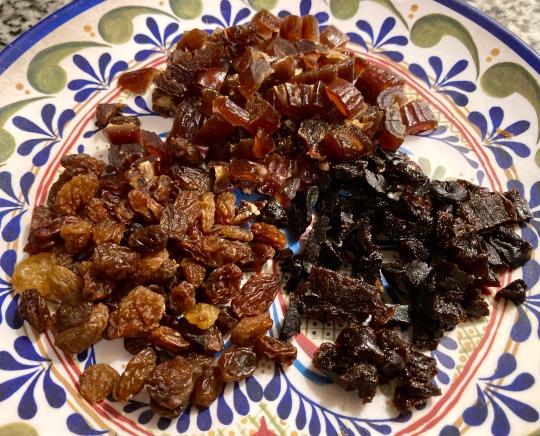
Instructions
1. Submerge wheat in water and scrub between your hands to clean and remove excess starch. Drain and cover by a couple inches with hot water. Cover and leave overnight.
2. Drain wheat and add to a large pot. Add water to cover and simmer for about 30 minutes until softened, stirring and adding more hot water as necessary.

Wheat before cooking
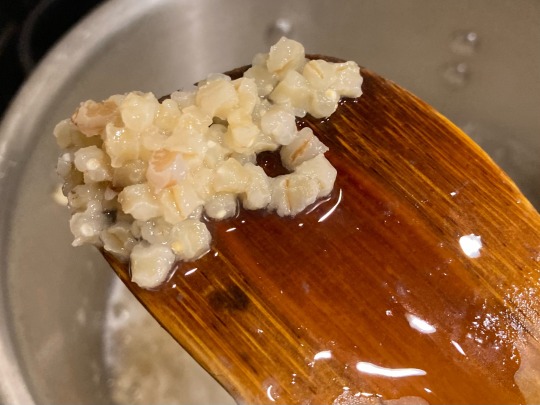
Wheat after cooking
3. Add dried fruit, sugar, salt, and spices and simmer for another 30 minutes, stirring occasionally, until wheat is very tender. Add water as necessary; the pudding should be relatively thin, but still able to coat the back of a spoon.
4. Remove from heat and stir in rosewater and honey. Ladle pudding into individual serving bowls and let cool in the refrigerator. Serve cold decorated with nuts and pomegranate seeds.
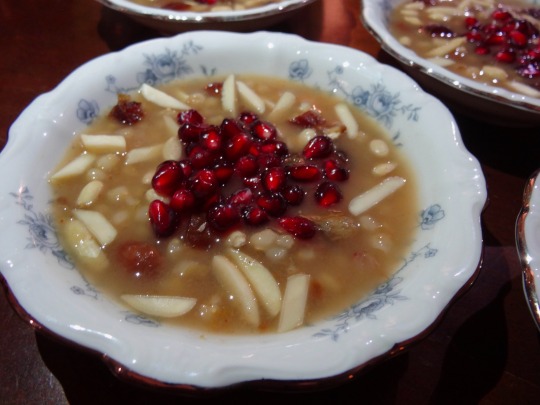
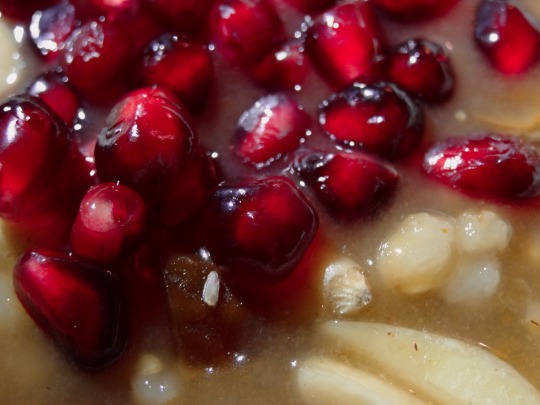
#the last link is a different / new fundraiser#Armenian#Palestinian#fusion#wheat berries#pearled wheats#pomegranate#prunes#dried apricot#dates#long post /
364 notes
·
View notes
Text
What's going on in the Armenian Quarter of Jerusalem? a timeline
Background
700s-1920s: Armenian Christians immigrate to Palestine, at first due to the holy sites there and later (after 1915) fleeing the Armenian genocide. Most of them end up living in a section of Jerusalem known as the Armenian Quarter. An Armenian church / Patriarchate is established that has authority over Armenian Apostolic Christians everywhere.
1923-1947: Britain (who had been given the "mandate," aka direct governmental control, of Palestine by other European colonial powers), empowers Patriarchates in Jerusalem (church leadership) to do things like select their own leaders and sell land without oversight from their communities. This gives Britain more authority and prevents regular Palestinian people from knowing what's going on when it comes to church business including secret real estate deals.
2005-2019: Land in Jerusalem belonging to the Greek Orthodox Patriarchate is sliced up, sold, and developed despite attempts to fight it in Israeli courts.
July 2021: The Armenian Patriarchate makes a deal leasing 2.7 acres of land to real estate / development company Xana Gardens (based in Dubai and owned by Israeli businessman Danny Rothman) for between 49 and 98 years. The deal is made without proper oversight and approval, including from within the Patriarchate.
The land in question includes the historical Cows' Garden (Hadiqa al-Baqar / حديقة البقر), now a parking lot; part of a church school; a garden; and five family houses. It makes up about 1/4 of the total land in the Armenian Quarter. No one knows that more than just Cows' Garden is affected.
Xana Gardens wants to build a luxury hotel on some of this land, including Cow's Garden.
Events in 2023
May: Details of the nature of the real estate deal come out. The government of Jordan (I think? these news reports are written in the passive voice) and Armenian institutions try to contact the Patriarchate to express concern about the handling of historically significant sites. The Patriarch does not respond.
11 May: Jordan and Palestine suspend their recognition of Patriarch Nourhan Manougian.
26 October: The Patriarchate announces that it has contacted Xana Gardens to cancel the deal. Xana Gardens does not respond.
Later on 26 October (around 3pm): Israeli bulldozers arrive at Cows' Garden and start tearing up pavement and demolishing a wall. Armenians rush to stand in front of bulldozers and prevent further destruction.
5 November: Rothman and other representatives of Xana Gardens arrive with 15 settlers and tell local Armenians that the land is theirs and they need to leave. Some of the settlers have guns and leashed dogs. About 200 Armenian Palestinians arrive and force the settlers to stand down.
12 and 13 November: Xana Gardens sends bulldozers to Cows' Garden. They do not have necessary permits. Armenians set up constantly rotating vigils at the Gardens and make barricades with pieces of metal and their cars.
15 November, 4:30pm: Israeli settlers drive a convoy of cars into the Garden. Armenians gather around the barricades. The police back the settlers and arrest three Armenians, including one child.
28th December: 30+ settlers attack a group of Armenian bishops, priests, deacons, and seminary students (including Bishop Koryoun Baghdasaryan, the director of the Patriarchate's real estate department) with sticks and nerve agents / tear gas, injuring several.
28th December, later: The Patriarchate releases a statement attributing the attack to Xana Gardens. The development company does not want the Patriarchate to continue trying to reverse the deal through the court system.
119 notes
·
View notes
Note
Sorry I misunderstood!!! 😭 I thought he meant it in a Catholicism related way
no worries!
by the way, since we're on this topic — we're not Catholic; we're Christians of the Armenian Apostolic Church. On top of this, The Kingdom of Armenia was the first state in history to adopt Christianity as its official religion in 301 AD (12 years before Rome)
25 notes
·
View notes
Text
[Azatutyun is US State Media]
Prime Minister Nikol Pashinian on Tuesday accused the organizers of continuing protests against his territorial concessions to Azerbaijan of trying to provoke another Armenian-Azerbaijani war with the aim of toppling him.
Pashinian claimed that Azerbaijan will invade Armenia if he bows to their demands to halt the handover of key border areas to Baku.
“If process is stopped, a war will break out,” he told a news conference. “I believe that this is [the protest leaders’] goal.”
“The forces that are demanding a halt to the border delimitation will do, with the help of some external forces, everything so that more territories of Armenia are occupied and use that for causing political changes in Armenia,” he said, adding they want to install a “puppet government.”
Pashinian spoke as hundreds of protesters led by Archbishop Bagrat Galstanian continued to march to Yerevan from the northern Tavush province that has comprised the border areas in question since the early 1990s. Many residents of adjacent Tavush residents are also strongly opposed to the unilateral land handover, citing serious security risks.
Galstanian brushed aside Pashinian’s “unserious” claims as he and the other marching protesters approached Charentsavan, a town 35 kilometers north of Yerevan. “Shame on him,” the outspoken clergyman told RFE/RL’s Armenian Service.
“We are fighting to make sure that there are no more wars in Armenia,” said Garnik Danielian, another protest leader and an opposition lawmaker. He said the protesters will reach Yerevan as planned on Thursday.
So far the protest leaders have not listed Pashinian’s resignation among their demands. They have attracted strong support from the Armenian opposition as well as other groups and individuals critical of the government.
Opposition leaders have dismissed Pashinian’s earlier claims that the territorial concessions are necessary for preventing Azerbaijani military aggression. They say he is on the contrary encouraging Baku to demand more territory from Armenia and use force for that purpose.
Pashinian on Tuesday described Robert Kocharian, a former president heading the main opposition Hayastan alliance, as a “beneficiary” of the ongoing protests which he said are led by Catholicos Garegin II, the supreme head of the Armenian Apostolic Church. Speaking one day before his planned visit to Moscow, he also implicitly accused them of collaborating with Russia.
Pashinian similarly accused Moscow of fomenting last September’s antigovernment protests in Yerevan sparked by an Azerbaijani military offensive in Nagorno-Karabakh.
7 May 24
14 notes
·
View notes
Text

Etchmiadzin Cathedral, Vagharshapat (Ejmiatsin), Armenia (source)
#altar#armenia#altars#Etchmiadzin cathedral#armenian apostolic church#Vagharshapat#Ejmiatsin#religious#oriental orthodoxy#church#Christianity#cathedral
70 notes
·
View notes
Text

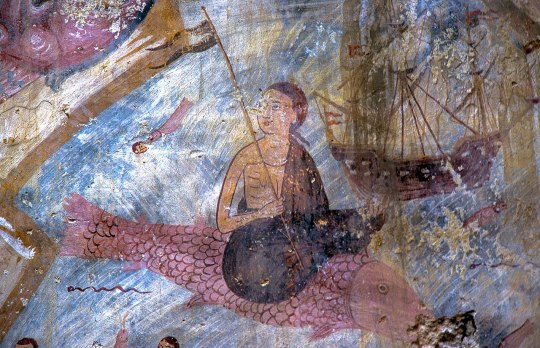




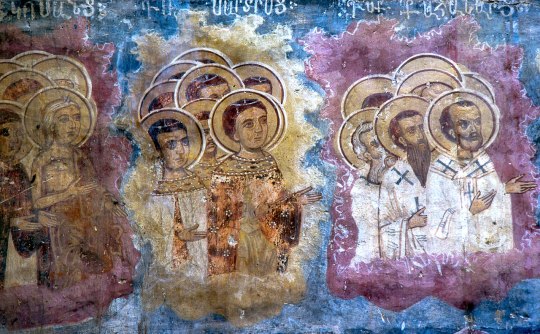
15th(?) century Armenian Apostolic Monastery of the All-Saviour (Ամենափրկիչ Վանք) near Trabzon.
#armenia#armenian#armenianblog#armenian churches#armenian apostolic church#oriental orthodox#armenian art#architecture
72 notes
·
View notes
Text


Flag Wars Bonus Round
12 notes
·
View notes
Text
How many books are in your Bible?
Somehow I ended up on the Wikipedia page for Biblical canon and now my head hurts so I'm throwing all of you into the rabbit hole with me.
All Christian denominations share the same twenty-seven books of the New Testament: Matthew, Mark, Luke, John, Acts, Romans, 1 and 2 Corinthians, Galatians, Ephesians, Philippians, Colossians, 1 and 2 Thessolonians, 1 and 2 Timothy, Titus, Philemon, Hebrews, James, 1 and 2 Peter, 1 2 and 3 John, Jude, and Revelation. (The Orthodox Tewahedo Church has an additional eight books, but they are not considered part of the Bible itself, just the broader religious canon.)
However, the Old Testament is where it gets complicated.
The Tanakh contains twenty four books divided into three sections: The Torah, the Nevi'im, and the Ketuvim. The Torah contains Genesis, Exodus, Leviticus, Numbers, and Deuteronomy. The Nevi'im contains Joshua, Judges, Samuel, Kings, Isaiah, Jeremiah, Ezekiel, Hosea, Joel, Amos, Obadiah, Jonah, Micah, Nahum, Habakkuh, Zephaniah, Haggai, Zechariah, and Malachi. The Ketuvim contains Psalms, Proverbs, Job, Ruth, Lamentations, Ecclesiastes, Esther, Daniel, Ezra and Nehemiah, and Chronicles.
The Protestant Old Testament took the canon of the Tanakh, divided some books into two and added another book, making a total of 39 books: Genesis, Exodus, Leviticus, Numbers, Deuteronomy, Joshua, Judges, Ruth, 1 and 2 Samuel, 1 and 2 Kings, 1 and 2 Chronicle, Ezra, Nehemiah, Esther, Job, Psalms, Proverbs, Ecclesiastes, Song of Solomon (also called Song of Songs), Isaiah, Jeremiah, Lamentations, Ezekiel, Daniel, Hosea, Joel, Amos, Obadiah, Jonah, Micah, Nahum, Habakkuh, Zephaniah, Haggai, Zechariah, and Malachi. Combing the Old and New Testaments, Protestant Bibles have 66 books.
The Catholic Bible includes the same 39 books as the Protestant Bible, with an additional seven books called the Deuterocanon: Tobit, Judith, Baruch, Sirach, 1 and 2 Maccabees, and Wisdom. Additionally, the books Esther and Daniel in the Catholic Bible contain more text than their Protestant counterparts. In total, the Catholic Bible has 73 books, 46 of those being the Old Testament.
The Greek Orthodox Bible includes the 46 books of the Catholic Old Testament, with an additional three: Prayer of Manasseh, 1 Esdras, and 3 Maccabees. Also, while the Protestant and Catholic Bibles contain 150 Psalms, the Greek Orthodox has 151. In total, the Greek Orthodox Bible contains 76 books.
The Slavonic Orthodox and Georgian Orthodox Bibles contain the same books as the Greek Orthodox.
The Armenian Apostolic Bible contains 50 Old Testament books: The 49 books in the Greek Orthodox Bible, and one other: 2 Esdras. This Bible contains Psalm 151. The Armenian Apostolic Bible contains 77 total books.
The Syrian Orthodox Old Testament has 48 books: All the books of the Catholic Old Testament with the additions of Prayer of Manasseh and 3 Maccabees. This Bible contains Psalm 151. The Syrian Orthodox Bible contains 75 total books.
The Coptic Orthodox Bible has 47 Old Testament books: All the books of the Catholic Old Testament with Prayer of Manasseh added. This Bible contains Psalm 151. The Coptic Orthodox Bible contains 74 books.
The Orthodox Tewahedo Bible is the canon for both the Ethiopian Orthodox Tewahedo Church and the Eritrean Orthodox Tewahedo Church. This Bible has the 39 Protestant Old Testament Books, and the additional books Jubilees, Enoch, Meqabyan, Ezra Sutuel, Tobith, and Judith. This Bible contains Psalm 151, and the books 2 Chronicles and Jeremiah are extended. The Orthodox Tewahedo Bible contains 73 books.
The Assyrian Church of the East has the 46 books of the Catholic Old Testament, plus two: Prayer of Manasseh and 3 Macabees. This Bible contains Psalm 151, and Baruch is extended. The Assyrian Church of the East Bible contains 75 books.
I hope this information serves you well if you ever end up on Who Wants to Be a Millionaire or something one day
25 notes
·
View notes
Text

THE DESCRIPTION OF SAINT JOHN PAUL II
The Patron of Kraków and World Youth Day
Feast Day: October 22
"There is no evil to be faced that Christ does not face with us. There is no enemy that Christ has not already conquered. There is no cross to bear that Christ has not already borne for us, and does not now bear with us." -from the Eucharistic Celebration Homily, October 1995
One of the greatest popes in the history of the Roman Catholic Church, and before he became known as John Paul the Great, he was born Karol Józef Wojtyła, on May 18, 1920 in Wadowice, Kraków Voivodeship, Poland.
When Karol was just eight years old, his happy family life was saddened by the early death of his parents, Karol Wojtyła, a non-commissioned officer of the Austro-Hungarian Army and captain of the Polish Armed Forces, and Emilia Kaczorowska, a schoolteacher who was of distant Lithuanian heritage, as he said: 'At twenty, I had already lost all the people I loved.'
His elder sister Olga had died before his birth, but he was close to his brother Edmund, nicknamed Mundek, who was 13 years his senior. Edmund's work as a physician eventually led to his death from scarlet fever, a loss that affected Wojtyła deeply.
Karol was an athletic youth, often played football as a goalkeeper, and also performed with various theatrical groups and worked as a playwright. During this time, his talent for language blossomed, and he learned as many as 15 languages including English and Esperanto. During the Nazi occupation of Poland, from 1940 to 1944, Karol worked in a limestone quarry and then in Solvay chemical factory.
In order to fulfill his vocation in October 1942 at the height of World War II, he entered the clandestine seminary of Kraków, run by Adam Stefan Sapieha, the archbishop of Kraków, and after finishing his studies at the seminary, he was ordained priest on All Saints' Day - November 1, 1946, a year after the war ended. He was first assigned in a small parish near Kraków, and then he served as professor and chaplain at the Catholic University of Lublin (now John Paul II Catholic University of Lublin). At a very young age, because of his exceptional talents, he became archbishop of Kraków and then Cardinal.
Following the death of John Paul I, ten days after the funeral, at the age of 58, Karol elected as pope on October 16, 1978, and chose the name John Paul II in honor of his predecessor. Having consecrated his papacy to the Blessed Virgin Mary, as his motto says: 'Totus Tuus', meaning 'I am all yours'.
He embarked in a tireless apostolate around the world. The Pilgrim Pope, as he was known, he visited 129 countries, and travelled more than all previous 263 Popes combined. Moreover, he is credited to be the spiritual inspiration behind the fall of Communism in 1991.
While visiting Jerusalem in March 2000, John Paul became the first pope in history to visit and pray at the Western Wall. In September 2001, amid post-11 September concerns, he travelled to Kazakhstan, with an audience largely consisting of Muslims, and to Armenia, to participate in the celebration of 1,700 years of Armenian Christianity.
On May 13, 1981, the anniversary of the apparition of Our Lady of Fatima, he was shot and critically wounded by Mehmet Ali Ağca, an expert Turkish gunman who was a member of the militant fascist group Grey Wolves, and he miraculously survived the assassination attempt in St. Peter's Square. Ağca was caught and restrained by a nun and other bystanders until police arrived. He was sentenced to life imprisonment. Two days after Christmas in 1983, John Paul II visited Ağca in prison. John Paul II and Ağca spoke privately for about twenty minutes.
The pope made two trips to the Philippines: the first on February 18, 1981 where Lorenzo Ruiz is beatified in Manila, to which is the first beatification ceremony to be held outside the Vatican, and in January 15, 1995, during the X World Youth Day, he offered Mass to an estimated crowd of between five and seven million in Luneta Park in the Philippines, which was considered to be the largest single gathering in Christian history. And because of his special relationships with them, he is also known as the 'Pope of the Youth'.
As an extension of his successful work with youth as a young priest,
John Paul II pioneered the international World Youth Days. He presided over nine of them: Rome, Buenos Aires, Santiago de Compostella, Częstochowa, Denver (in the state of Colorado), Manila, Paris, and Toronto. The total attendance at these signature events of the pontificate was in the tens of millions. The Great Jubilee of 2000 was a call to the church to become more aware and to embrace his missionary task for the work of evangelization.
During the final days of the pope's life, the lights were kept burning through the night where he lay in the Papal apartment on the top floor of the Apostolic Palace. Tens of thousands of people assembled and held vigil in St. Peter's Square and the surrounding streets for two days. Upon hearing of this, the dying pope was said to have stated: 'I have searched for you, and now you have come to me, and I thank you.'
After a long and painful sickness, John Paul II went home to the Lord, on a sorrowful Saturday, April 2, 2005 at the age of 84, at the Apostolic Palace in the Vatican. His final words were: 'Pozwólcie mi odejść do domu Ojca. (Allow me to depart to the house of the Father.)'
He was beatified by Pope Benedict XVI on May 1, 2011, and three years on April 27, 2014 on Divine Mercy Sunday, together with Pope John XXIII, he was canonized a saint by Pope Francis.
#random stuff#catholic#catholic saints#karol józef wojtyła#john paul ii#pope john paul ii#pope st. john paul ii#john paul the great
4 notes
·
View notes
Text

A VERY AURORA BAY CHRISTMAS
layla doesn't have room in her apartment for a tree, seeing as most of her space is taken by a forrest of plants. so this year she decided to decorate said forrest. with her own little 'tonatsar' made from a plant on her desk. never caring much for the season as a child, as it was mostly spent in her parents old bar or an armenian apostolic church, she's decided to make new traditions.
@aurorabayaesthetic
3 notes
·
View notes